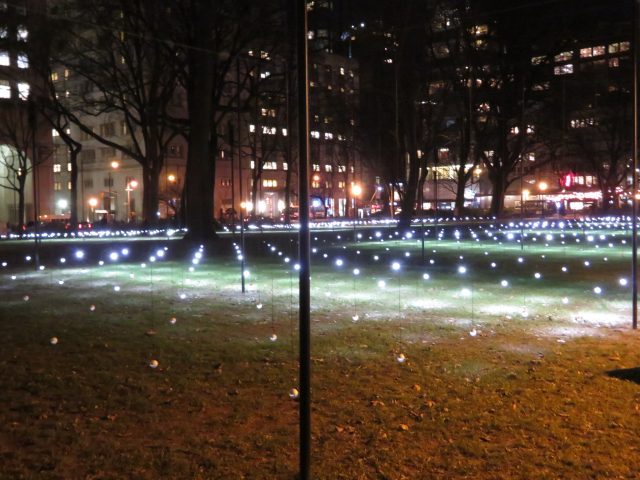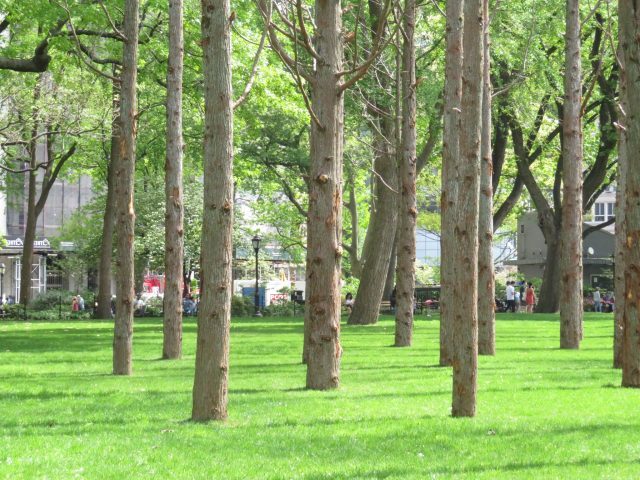
Maya Lin’s Ghost Forest will decompose in Madison Square Park through mid-November (photo by twi-ny/mdr)
Madison Square Park Oval Lawn
Exhibition continues through November 14
madisonsquarepark.org
whatismissing.net
Postponed for a year because of the pandemic, Maya Lin’s Ghost Forest is up and dying a slow death in Madison Square Park. The exhibition shines a light on climate change, logging practices, environmental degradation, extreme deprivation, and other human interventions that are destroying the natural world. Ghost Forest consists of forty-nine forty-foot-tall Atlantic white cedars from the Pine Barrens in New Jersey. The bare trees, around eighty years old, are not technically dead yet, but they will wither away through November 14 as the grass and trees of the park turn green around them over the summer before fading as fall heads into winter. “Throughout the world, climate change is causing vast tracts of forested lands to die off,” Lin says in her artist’s statement. “They are being called ghost forests; they are being killed off by rising temperatures, extreme weather events that yield saltwater intrusion, forest fires, and insects whose populations are thriving in these warmer temperatures, and trees that are more susceptible to beetles due to being overstressed from these rising temperatures. In southwestern Colorado where my family and I live in the summer, these forests — killed off by beetles — are all around us. As I approached thinking about a sculptural installation for Madison Square Park, I knew I wanted to create something that would be intimately related to the park itself, the trees, and the state of the earth.”
The “gentle giants,” as Lin calls them, form a kind of twisting maze that visitors can walk through (except in the rain.) The bare trunks and branches evoke griefs large and small: It’s hard not to think of the isolation and loss of the past fourteen months of the Covid-19 crisis; in addition, Lin’s husband, photography collector and dealer Daniel Wolf, died of a heart attack in January at the age of sixty-five. The display was supposed to consist of fifty trees, but one didn’t survive the transport, another fatality. Lin is most well known for her Civil Rights Memorial in Montgomery, Alabama, and the Vietnam Veterans Memorial in Washington, DC; other earthworks and environmental installations by Lin include The Secret Life of Grasses at Storm King, Map of Memory: Hudson River Timeline at the Hudson River Museum, Seven Earth Mountain at Pier 94, A History of Water at the Orlando Museum of Art, and the 2011 short film Unchopping a Tree, which asks, “If deforestation were happening in your city, how quickly would you work to stop it?”
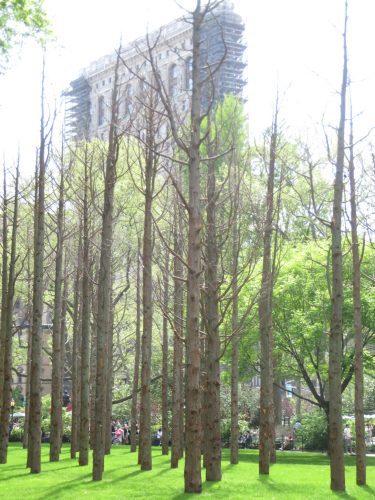
Forty-nine bare trees rise like doomed skyscrapers in Maya Lin’s Ghost Forest (photo by twi-ny/mdr)
Ghost Forest is part of Lin’s “What Is Missing?” project, an online global memorial where people can share memories of something from the natural world that has disappeared or is diminishing or discuss specific examples of ecological conservation and restoration. Be sure to listen to Ghost Forest Soundscape, thirteen minutes of sounds made by the gray fox, cougar, barred owl, American black bear, elk, harbor seal, bat, beaver, bottle nose dolphin, and wild turkey, a powerful reminder of living beings that once could be heard and seen in and around New York; in conjunction with Ghost Forest, there will also be a series of in-person and online talks. “We will be coordinating public programs that focus on nature-based solutions to climate change as well as highlighting the ecological history of Manhattan through a soundscape of species that were once common in the city,” Lin explains. “We are faced with an enormous ecological crisis — but I also feel that we have a chance to showcase what can be done to help protect species and significantly reduce the climate change emissions by changing our relationship to the land itself.” To counteract the project’s carbon footprint, Lin, the Natural Areas Conservancy, and the Madison Square Park Conservancy will be planting more than one thousand trees and shrubs across all five boroughs.
From June 1 to 11, the public is invited to answer the question “How has climate change altered your daily life?”; the responses will be posted on a reflection board at the north corner of the Oval Lawn as well as on social media. On June 4 at 9:00 am (free with advance RSVP), the park will host, on Zoom, its sixth annual public art symposium, “Greening Public Art,” highlighted by a keynote conversation with Lin, Rodale Institute board member Maria Rodale, Nature Conservancy in New York executive director Bill Ulfelder, and Perfect Earth Project founder Edwina von Gal, moderated by Andrew Revkin of the Earth Institute at Columbia. Other speakers include Una Chaudhuri, Marina Zurkow, Anita Fields, Nicholas Galanin, Allison Janae Hamilton, Tavares Strachan, and Lucia Pietroiusti and moderator Sarah Douglas. On June 15 at 6:00, the park and Fotografiska New York team up for an art talk with Gabriella Demczuk, who documents ghost forests across the United States; advance registration is required. On September 21 at 6:00 Fotografiska will host an art talk with Lin and Elizabeth Kolbert as part of Climate Week NYC, followed October 19 at 6:00 with Lin and von Gal discussing climate change with moderator Sarah Charlop-Powers. And on November 9 at 6:00, Fotografiska will livestream David Scott Kessler’s experimental film The Pine Barrens, with a live score by the Ruins of Friendship Orchestra. If only the world would listen.
In addition, Music on the Green is a series of live concerts with Carnegie Hall held on Wednesday nights within Ghost Forest; below is the full lineup:
Wednesday, July 7, 6:00
Music by Barber, Bartók, Copland, Caroline Shaw, others
Cort Roberts, horn
Adelya Nartadjieva, violin
Gergana Haralampieva, violin
Halam Kim, viola
Madeline Fayette, cello
Wednesday, July 14, 6:00
Music by Messiaen, Copland, Kaija Saariaho, Reena Esmail, others
Leo Sussman, flute
Wilden Dannenberg, horn
Jennifer Liu, violin
Halam Kim, viola
Madeline Fayette, cello
Wednesday, July 21, 6:00
Bach’s Goldberg Variations, India Gailey’s Mountainweeps, John Luther Adams’s Three High Places, others
Halam Kim, viola
TBD, violin
Arlen Hlusko, cello
Wednesday, July 28, 6:00
Andrea Casarrubios’s Speechless, Leven Zuelke’s At a Cemetery, and works by Ravel, Fauré, Debussy, and Ellington
Sae Hashimoto, percussion
Suliman Tekalli, violin
Ari Evan, cello
Wednesday, August 4, 6:00
Satie’s Gnossiennes, John Psathas’s Fragment, and works by Duke Ellington and Chick Corea
Ian Sullivan, vibraphone
Sae Hashimoto, marimba
Wednesday, August 11, 6:00
Hans Abrahamsen’s wind quintet Walden, Hannah Lash’s Leander and Hero, and works by Beach, Piazzolla, Still, others
Amir Farsi, flute
Stuart Breczinski, oboe
Yasmina Spiegelberg, clarinet
Nik Hooks, bassoon
Cort Roberts, horn
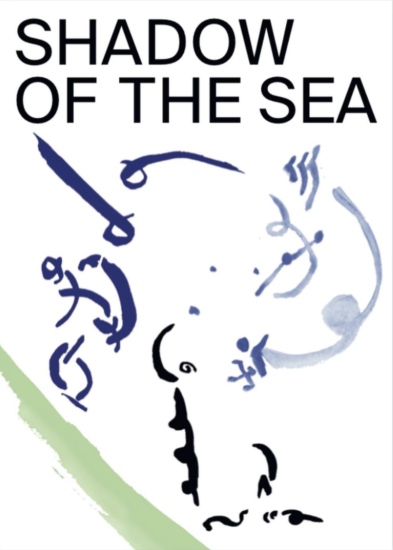
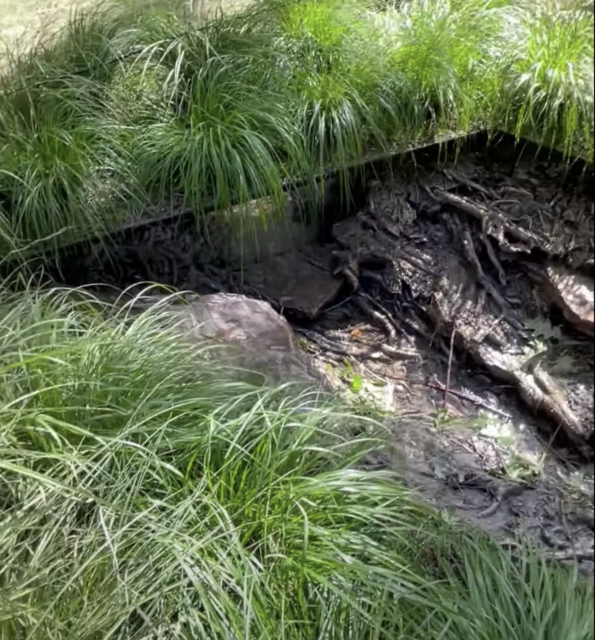


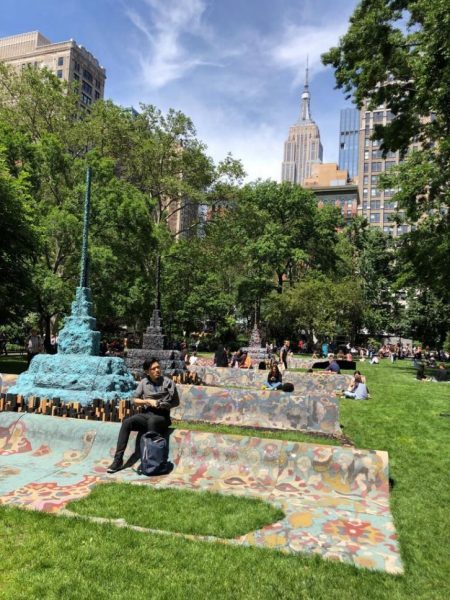
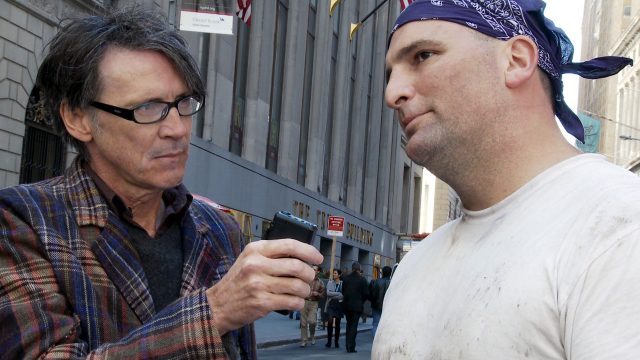
 In October 2008, in the midst of the Barack Obama / John McCain presidential election and the mortgage crisis, filmmaker Rachel Shuman took to the streets of New York City with Clay Pigeon, host of The Dusty Show on WFMU, interviewing people as they made their way across Manhattan and other boroughs. The Boston-born, Beacon-based Shuman intended to capture a moment in time and not release the film until after Obama’s second term ended to see how life in the city changed. The result is One October, a kind of love letter to who we were, are, and will be. Inspired by Chris Marker’s 1963 film Le Joli Mai, in which the French director interviewed people on the streets of Paris, Shuman follows Pigeon, Radio Shack mini tape recorder in hand, as he wanders through Central Park, Harlem, Washington Square Park, the Lower East Side, Madison Square Park, the Financial District, the Brooklyn Bridge, Willets Point, Tompkins Square Park, and other locations, approaching a series of men and women who share fascinating details about their personal and professional lives; the Iowa-born Pigeon has an innate knack for quickly understanding his subjects, asking intuitive questions that often surprise them. He speaks with a former freelance photographer who now works construction to make more money for his family, an ambitious lawyer who wants to work at the UN, a mixed-race couple sitting on a bench, a woman railing against the gentrification of Harlem, and a homeless man who turns the tables on the soft-spoken Pigeon. “It’s always interesting to see how the random collection of souls falls together and how the next chapter bears fruit or lies fallow,” he says on his radio show.
In October 2008, in the midst of the Barack Obama / John McCain presidential election and the mortgage crisis, filmmaker Rachel Shuman took to the streets of New York City with Clay Pigeon, host of The Dusty Show on WFMU, interviewing people as they made their way across Manhattan and other boroughs. The Boston-born, Beacon-based Shuman intended to capture a moment in time and not release the film until after Obama’s second term ended to see how life in the city changed. The result is One October, a kind of love letter to who we were, are, and will be. Inspired by Chris Marker’s 1963 film Le Joli Mai, in which the French director interviewed people on the streets of Paris, Shuman follows Pigeon, Radio Shack mini tape recorder in hand, as he wanders through Central Park, Harlem, Washington Square Park, the Lower East Side, Madison Square Park, the Financial District, the Brooklyn Bridge, Willets Point, Tompkins Square Park, and other locations, approaching a series of men and women who share fascinating details about their personal and professional lives; the Iowa-born Pigeon has an innate knack for quickly understanding his subjects, asking intuitive questions that often surprise them. He speaks with a former freelance photographer who now works construction to make more money for his family, an ambitious lawyer who wants to work at the UN, a mixed-race couple sitting on a bench, a woman railing against the gentrification of Harlem, and a homeless man who turns the tables on the soft-spoken Pigeon. “It’s always interesting to see how the random collection of souls falls together and how the next chapter bears fruit or lies fallow,” he says on his radio show.